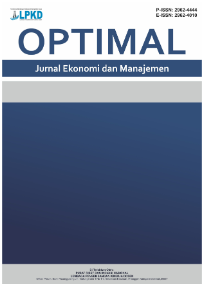When Technology Meets Financial Behavior: A Household-Level Study on Digital Payment, Literacy, and Connectivity in Indonesia
DOI:
https://doi.org/10.55606/optimal.v5i2.5876Keywords:
Digital Payment, Literacy, Connectivity, Household FinancialAbstract
The rapid expansion of digital financial services has significantly transformed household financial behavior, particularly in developing economies. However, the effectiveness of these tools in improving household financial efficiency depends not only on their usage but also on users' digital literacy and access to supporting infrastructure. This study aims to examine the influence of digital payment system usage, digital financial literacy, and internet access on household financial efficiency in the context of Indonesia's digital economy. A quantitative survey was conducted among 120 households in Banyumas Regency, Central Java, using a structured questionnaire. Data were analyzed using multiple linear regression after validating assumptions of normality, multicollinearity, and heteroscedasticity. The variables measured included frequency of digital payments, financial literacy levels, internet accessibility, and self-reported financial efficiency. The results indicate that all three independent variables significantly and positively affect household financial efficiency, with digital financial literacy exerting the strongest influence. Digital payment usage and internet access also contributed significantly. These findings suggest that financial efficiency is not merely a function of access or usage but is strengthened when supported by adequate literacy and infrastructure. The study highlights the interdependent role of behavioral and structural factors in enabling effective household financial management. This research contributes to the growing literature on digital financial behavior by focusing on the household level in a semi-urban setting. The findings offer practical implications for policymakers, fintech developers, and financial educators aiming to promote inclusive and efficient digital financial ecosystems.
References
Akir, Z. (2003). Diffusion of innovations. In Education and Technology: An Encyclopedia (Vols. 1–2). Free Press. https://doi.org/10.4337/9781800883284.diffusion.of.innovations
Arifin Z, Rahman F, P. A. (2021). Digital financial services and household budgeting behavior: Evidence from Indonesia. International Journal of Economics and Management, 1(15), 83–96.
Bank Indonesia. (2018). Statistik Sistem Pembayaran. In Bank Indonesia. https://www.bi.go.id/id/e404.aspx
Chen Y, Wu Y, H. Y. (2022). Impact of mobile payment on household consumption and financial planning: Evidence from Chinese urban families. Electronic Commerce Research and Applications, 3(22), 495–520.
Dwipayana IG, Wicaksana IGN, S. D. (2023). Pengaruh akses internet terhadap inklusi keuangan di daerah semi-perkotaan: Studi di Provinsi Bali. Jurnal Ekonomi Dan Pembangunan Indonesia, 1(24), 45–56.
Flury, B., Murtagh, F., & Heck, A. (1988). Multivariate Data Analysis. In Mathematics of Computation (Vol. 50, Issue 181). Cengage Learning. https://doi.org/10.2307/2007941
J, M., & A, A. K. (2020). Business Research Methods. In Business Research Methods. South-Western Cengage Learning. https://doi.org/10.22573/spg.020.bk/s/026
Lusardi, A., & Mitchell, O. S. (2014). The economic importance of financial literacy: Theory and evidence. Journal of Economic Literature, 52(1), 5–44. https://doi.org/10.1257/jel.52.1.5
OECD. (2021). Digital Financial Literacy: OECD/INFE Policy Guidance.
Putri RA, N. S. (2021). Internet connectivity and the digital divide in semi-urban financial inclusion. Jurnal Teknologi Dan Masyarakat, 2(17), 145–160.
Sekaran U, B. R. (2019). Research Methods for Business: A Skill-Building Approach. Wiley.
Sugiyono, P. D. (2018). Metode penelitian bisnis: pendekatan kuantitatif, kualitatif, kombinasi, dan R&D. Alfabeta. In Penerbit CV. Alfabeta: Bandung (Vol. 225). https://books.google.co.id/books?id=aFHZzwEACAAJ
Suryanto T, Thalassinos EI, T. Y. (2020). Fintech and household financial efficiency: Empirical evidence from Indonesia. International Journal of Economics and Business Research, 1(20), 102–118.
Susetyo, D. P., & Firmansyah, D. (2023). Literasi Ekonomi, Literasi Keuangan, Literasi Digital dan Perilaku Keuangan di Era Ekonomi Digital. Economics and Digital Business Review, 4(1), 261–279.
Williamson, O. E. (2019). Transaction-cost economics: The governance of contractual relations. Corporate Governance: Values, Ethics and Leadership, 2(22), 133–162. https://doi.org/10.1093/oso/9780198774358.003.0007
Xu L, Zhang R, W. J. (2021). Financial literacy in the digital age: A systematic review and future directions. Journal of Financial Services Marketing, 2(26), 111–123.
Zulfiqar G, Wahid F, K. M. (2021). Integrating financial literacy and technology adoption for household financial resilience. Journal of Financial Services Marketing, 4(26), 209–225.
Downloads
Published
How to Cite
Issue
Section
License
Copyright (c) 2025 OPTIMAL Jurnal Ekonomi dan Manajemen

This work is licensed under a Creative Commons Attribution-ShareAlike 4.0 International License.








